Dear Artist,
Yesterday, while hanging out in my studio with some fellow travellers, we got worked up about squinting. We agreed it is one of the most important things we do. “Squinting demands a twice-weekly letter on its own,” someone said, pushing me into a corner and roughing me up a bit. While being beat upon, I was remembering how Richard Schmid dedicated an entire painting video to The Secret Squint. Being a believer, I’ll explain:
Looking at work with half-closed eyes has several benefits — and there are several ways to do it. We have to agree that establishing an effective pattern — the overall compositional integrity of a design — is valuable. Simply put, squinting makes notes of weak areas. Squinting tells you what’s wrong and what’s bad. Squinting lets you know where darkness or lightness might be added. Even high-key equal-intensity work can be improved by squinting. Artists must know that compositions “form up” with patches of tone or colour. Interestingly, these needed patches can often use general rather than precise placement.
By squinting, the eye can be made to defocus, or, by further reforming the shape of the eyeball, bring subjects into sharper focus. Also, by drawing together the eyelids like an external iris diaphragm, you see the subject as more or less reduced to black and white. When work is viewed without the benefit of colour, decisions can be more readily made. It seems that in standard easel-working vision, you “can’t see the forest for the trees.” The squint becomes a quick and easy re-evaluation technique that simply gives the artist a second opinion.
Funnily, it’s not always easy to remember to do it. Like swizzling your brushes, squinting really needs to be built into your habit pattern. A plan is to make sure every work session has a dedicated squinting period. Consciously sit back and squint at the whole work and its particulate areas. Your brush will inevitably go where needed.
Another great ploy is the “multiple squint.” This is where several works are placed side by side on an easel and squinted as a group. It’s a remarkable experience, as weak works are contrasted by proximity to stronger ones. As well as benefiting from the mutual feed that one work gives to the other, the multiple squinter gets an overall understanding of stylistic direction.
Best regards,
Robert
PS: “Never knowingly leave anything wrong on your canvas.” (Richard Schmid)
Esoterica: If your work process takes you to middle tones first, and you habitually leave your darker darks and lighter lights till last, the calculated squint can guide your latter hand. An advantage of this system is the avoidance of the almost inevitable tightening up that occurs when works near completion. Squinting sees the big picture and keeps your work true to its higher ideals. As they left the studio, my friends dropped a few bouquets: “Tell them to learn to squint,” said one. “The world will never have enough squinters,” said another. Yet a third said, “Squinters of the world, arise; you have nothing to lose but your crap.”
This letter was originally published as “In praise of the squint” on April 27, 2007.
Have you considered a Premium Artist Listing? With each letter, an artist is featured at the bottom of this page. The Premium Artist Listings are a means of connecting artist subscribers through their work. Proceeds from each listing contribute to the production of The Painter’s Keys.
“It often takes two to do a good painting – one to paint it, and another to rap the painter smartly with a hammer before he or she can ruin it.” (Richard Schmid)
Featured Workshop
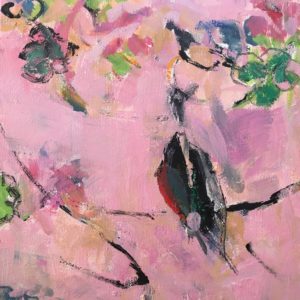 Permission to Paint Expressively Series Session 2
Permission to Paint Expressively Series Session 2
August 22-25, 2022
Join Ellie Harold for “Expressive Painting: Making Your Marks.” With a focus on intuitive mark-making, this workshop is designed to facilitate a fuller expression of your deepest and most essential artist Self. Content, process and lightly structured exercises give you permission to create the art that wants to be made by you in the safe space of Ellie’s studio and the fresh air and cool light of northern Michigan near Sleeping Bear Dunes. You’ll return home with a specific art “care plan” to assure support for “Making Your Marks” in the world. Details and registration at www.EllieHarold.com.
Featured Artist
I was trained to become an Illustrator and did Illustration work for over 25 years. That experience gave me the discipline and skills to do a wide variety of subjects and in different mediums. Because of that I have been honored to be a “Designated Master” with both the American impressionist Society and the Oil Painters of America. I consider myself a “Traditional/Impressionist” and have worked hard to strive to keep my standards up and make a good work of art. As I tell my students..”an accomplished painting has an interesting and beautiful arrangement of shapes and colors”. That is what I strive to do, regardless of subject matter; to make a decent “work of Art”. I also have always loved to travel and am fascinated by different peoples and their cultures along with all of the beautiful and interesting landscapes that are part of this wonderful world that we live in. I feel very fortunate that I get to do what I really love to do.

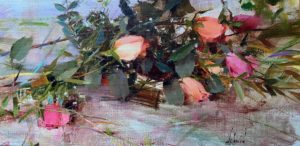
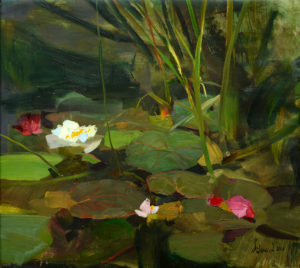
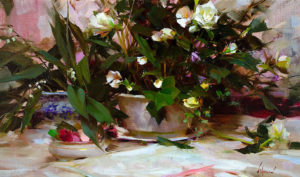
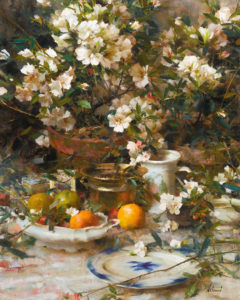
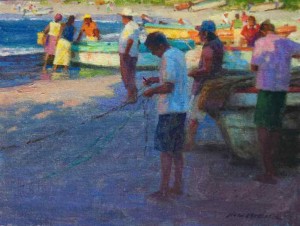



11 Comments
Great tip! Holding up to a mirror is another, or view from a distance up-side-down to evaluate balance and composition . One ‘s perception is altered from the usual which allows for correcting flaws which can fall to the illusion of an artist under the influence of the Muse. When the work is done, have a glass of wine and view through the relaxed mode of the analytic suspended.
Eva Nolan
Ah, such a squintessential tip! When painting I generally squint during the process, but I’m also a
Printmaker, so that’s a rather diff kettle of cod.
But most print processes reverse the composition, which, like the mirror trick, offers another opportunity to see flaws before printing. Thanks for the reminder.
a squinter from Day 1 this explains all my Life Lines around my eyes ;) <3
Thank you! http://www.socirty6.com/julienorthey and paintings by Julie Northey on Facebook
I’m so short sighted just standing 10 feet away is enough, no need to squint. I remember when I was first painting in my teens, I used to use one weak eye to blur my vision to look at my paintings while working on them. I remember panicking over doing that thinking I was losing my eyesight. Funny how I just naturally did that without realizing I was doing something all artist’s should do, squint or blur, it’s a good thing.
Oh yes – squinting is imperative but why oh why was Robert being roughed up in the corner? Did he put that in to see if we were paying attention?
Thank you for the fantastic article! Such good advice! Gives me a good reason to take of my coke-bottle glasses and do something useful with my otherwise poor eyesight.
Mirror, upside down viewing- – add:
Red filter to reveal pattern of values-
Reducing glass. Stand in place and get view from 10 feet away.
Keep checking back to your original resource
Material.
When it comes to assessing “the overall compositional integrity of a design”, I have found that ‘squinting’ is often an invaluable exercise. During my years as a Set Designer working in Theatre, ‘squinting’ at sketches, renderings and, especially, the maquette (model) rarely failed to ‘refresh my objectivity’. Perhaps the practice of ‘squinting’ might benefit some of the Politicians in this country in maintaining some “compositional integrity” in the words they use in making speeches, whether they are promoting their actions or responding to current events. Sadly, more often than not, their words are chosen by speechwriters and advisors whose names have rarely appeared on a ballot. Instead, we are constantly bombarded in the media with brief clips littered with eye-rolling platitudes and ‘trending’ buzz-words. What might well be ‘outrage’ is expressed merely as being ‘disappointed’. In expressing their positive feelings towards making announcements, they invariably declare that they are ‘excited’, even though their actual enthusiasm remains barely visible. Despite its recently constant and habitual usage in Marketing and Politics, I still haven’t the faintest idea what ‘moving forward’ actually means. In responding to the Russian invasion of Ukraine, our own Prime Minister described it as “absolutely unacceptable”. Unacceptable? I tend to use the word ‘unacceptable’ on such occasions as the food I had ordered arriving late or being cold. I think next Christmas I’ll send the PM a Thesaurus!
No one has mentioned Notan. Have a look at this:
https://mitchalbala.com/compositional-studies-with-the-notanizer-app/
Squinting truly unveils a new perspective on the art of observation revealing nuances often overlooked. A dedicated squinting session might just become a staple in my artistic routine.
Houses for Sale in Houston TX
I appreciate your wonderful essay. What great counsel! gives me an excuse to remove my coke bottle glasses and use my otherwise weak vision for something worthwhile.